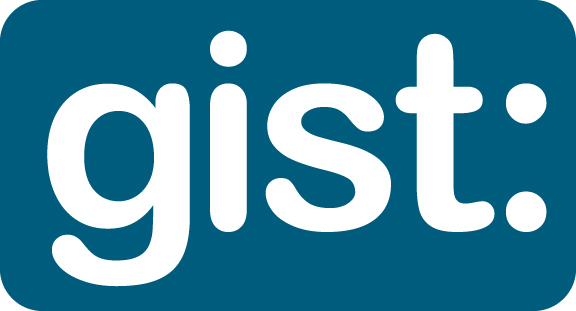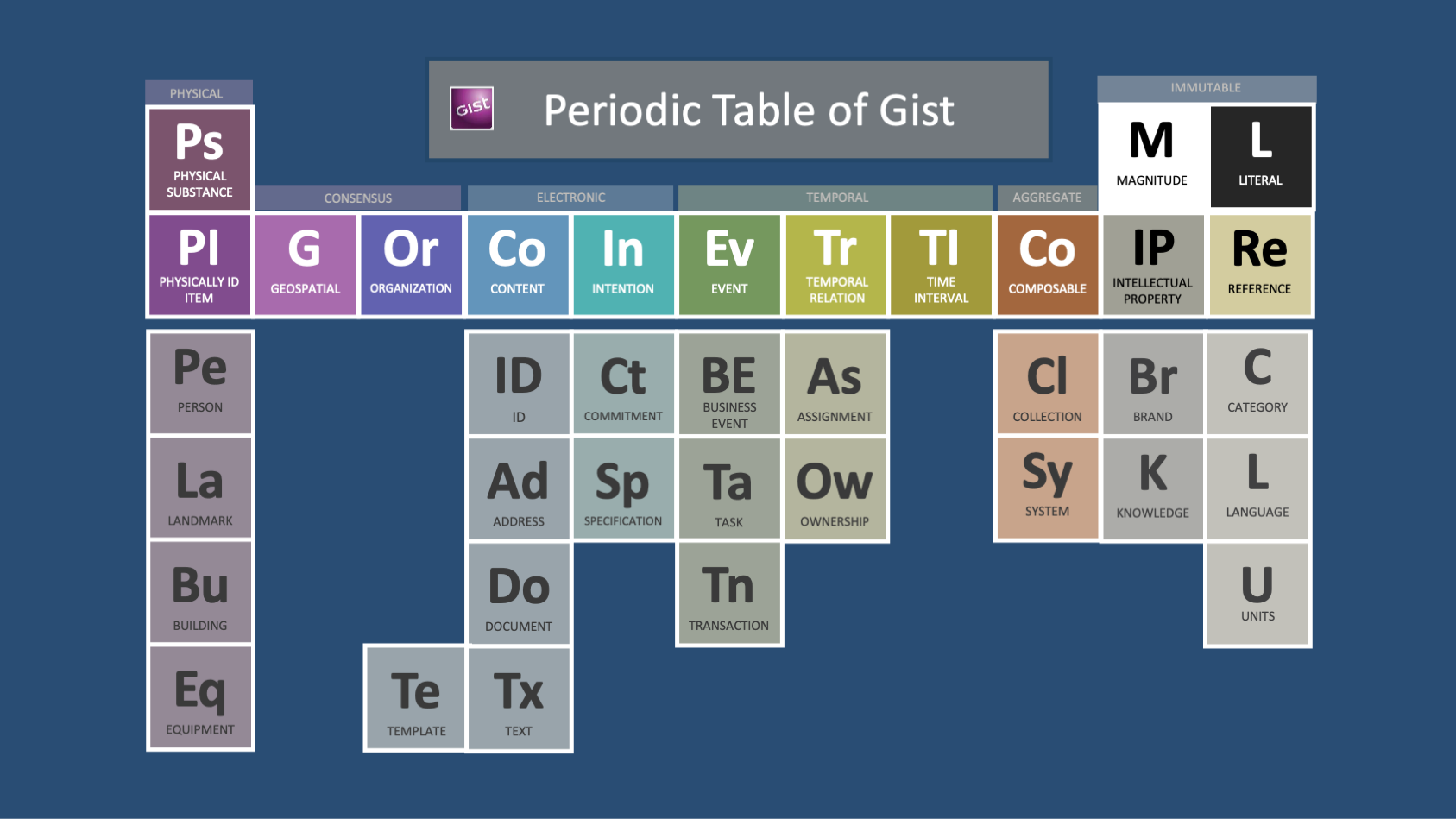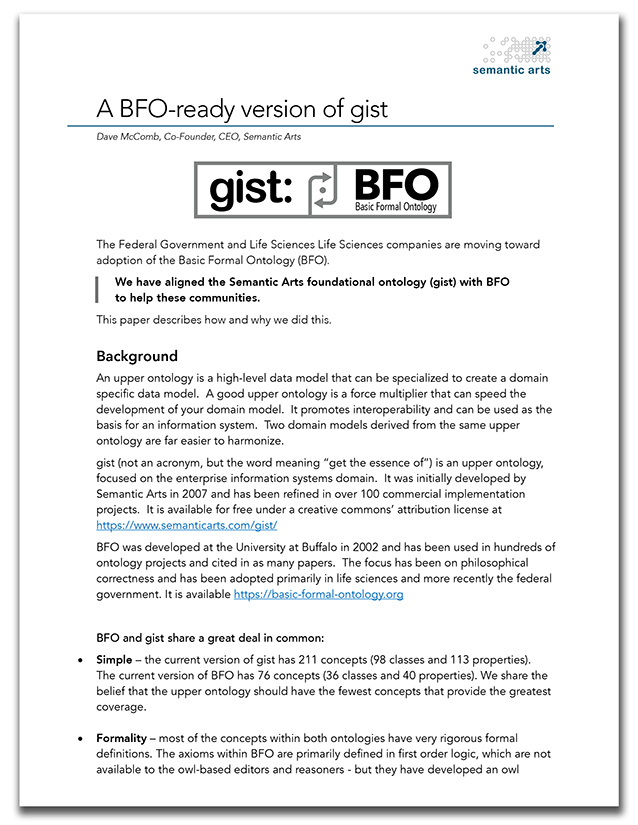
an open-source upper ontology
gist represents the fundamental concepts and relationships that exist for most business use cases and is specifically designed to be domain independent. This flexibility allows gist to be applied to a wide spectrum of domains and facilitates both interoperability and integration of knowledge. We have designed gist for clarity and completeness to cover nearly all the concepts that exist in real-world ontology development.
gist is an upper-level ontology containing a minimal set of concepts required for most business applications. It has been developed and maintained by Semantic Arts since 2012. The gist ontology is free to use and is distributed under the Creative Commons CC BY 4.0 license. You can use it as you see fit for any purpose, as long as you give us attribution and keep it in the gist namespace.
The Periodic Table of Gist
The gist ontology consists of just over 135 classes and about 140 properties and serves as a foundation for building more specialized ontologies. We have culled out highly abstract concepts to promote disambiguation. You are invited to contribute to gist by adding your comments to issue discussion threads and submitting new issues and pull requests.
gist Resources
gist resources are available in the following GitHub repositories:
Download gist
Two quick-start ways to get the latest version of gist:
- Download the latest gist release package
- Import gist directly into Protégé with this link: [https://w3id.org/semanticarts/ontology/gistCore]
gist Forum
We maintain an active gist community where practitioners and users of gist come together to discuss the gist model, implementation best practices, and evolution. Virtual meetings take place the third Thursday of each month. Click here to become involved.
gist Articles & Video Resources
2024
A BFO-ready version of gist
Dave McComb / October, 2024
Background
An upper ontology is a high-level data model that can be specialized to create a domain specific data model. A good upper ontology is a force multiplier that can speed the development of your domain model. It promotes interoperability and can be used as the basis for an information system. Two domain models derived from the same upper ontology are far easier to harmonize.
gist (not an acronym, but the word meaning “get the essence of”) is an upper ontology, focused on the enterprise information systems domain. It was initially developed by Semantic Arts in 2007 and has been refined in over 100 commercial implementation projects.
Read The Article
2023
- VIDEO: Toward a knowledge ontology, part 1 [LINK]
- VIDEO: Toward a knowledge ontology, part 2 [LINK]
- VIDEO: Temporal relations [LINK]
- VIDEO: Removal of inverses: [LINK]
- ARTICLE: knowledge graph modeling using gist [LINK]
- ARTICLE: gist jumpstart [LINK]
- ARTICLE: extending an upper-level ontology (like gist) [LINK]
2022
- VIDEO: Ontology documentation (what are the best routes for us to take with gist): [LINK]
- VIDEO: gist: An introduction [LINK]
- VIDEO: An introduction to gist, part 1: [LINK]
- VIDEO: An introduction to gist, part 2: [LINK]
- VIDEO: An introduction to gist, part 3: [LINK]
- VIDEO: gist/BFO comparison: [LINK]
- ARTICLE: get the gist, start building simplicity now [LINK]
2021
- VIDEO: gist Council: versioning and depreciation: [LINK]
- VIDEO: gist Council: modeling with gist categories: [LINK]
- VIDEO: gist Council: does anybody use that, part 1: [LINK]
- VIDEO: gist Council: does anybody use that, part 2: [LINK]
- VIDEO: gist Council: categories and classes: [LINK]
- VIDEO: gist Council: using the gist ID: Class: [LINK]
- VIDEO: gist Council: documentation: [LINK]
- ARTICLE: telecom frameworx model [LINK]
2020
- VIDEO: De-modularize gist: [LINK]
- VIDEO: Working with dates in gist, OWL and RDF: [LINK]
- VIDEO: Part of: musings on mereology: [LINK]
- VIDEO: SemOps: DevOps for semantic systems: [LINK]
- VIDEO: General overview: [LINK]
- VIDEO: Events: [LINK]
- VIDEO: Entity/ Identity resolution: [LINK]
- VIDEO: gist Council – change management [LINK]
- VIDEO: Everyday modeling challenges, part [LINK]
- ARTICLE: A brief introduction to the gist Semantic Model [LINK]



